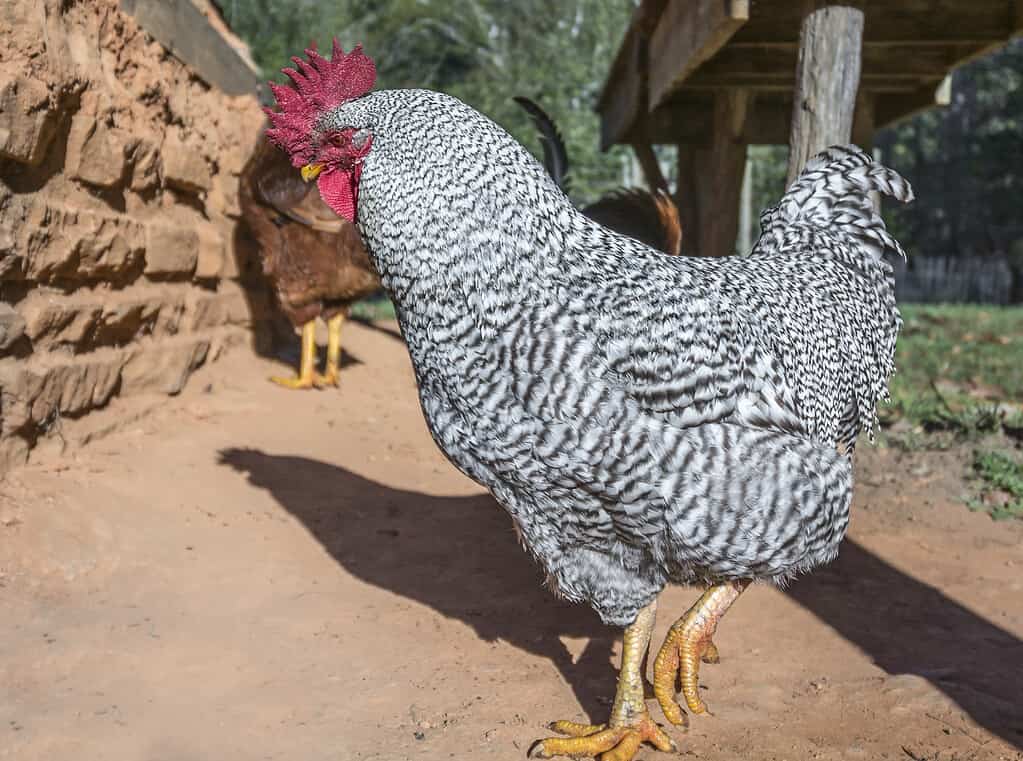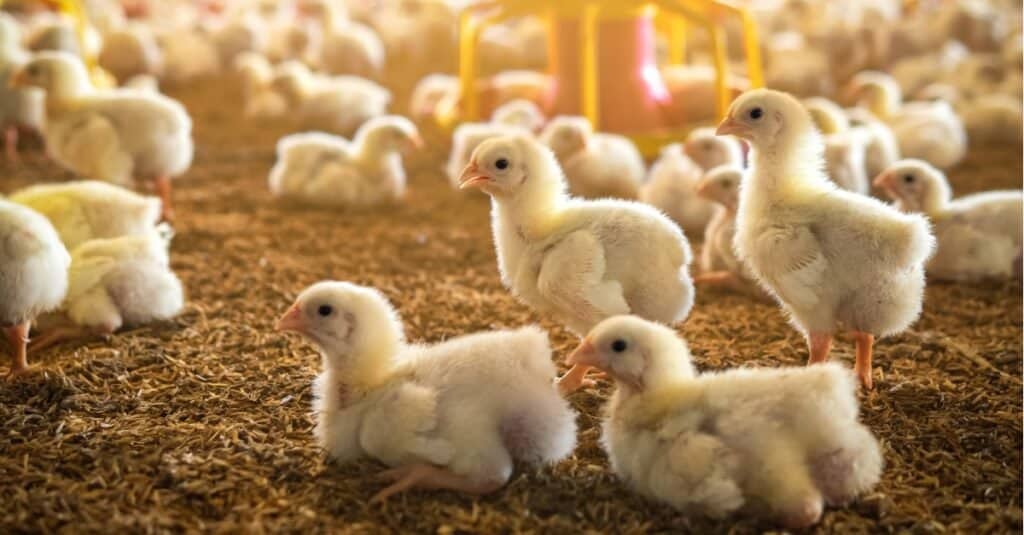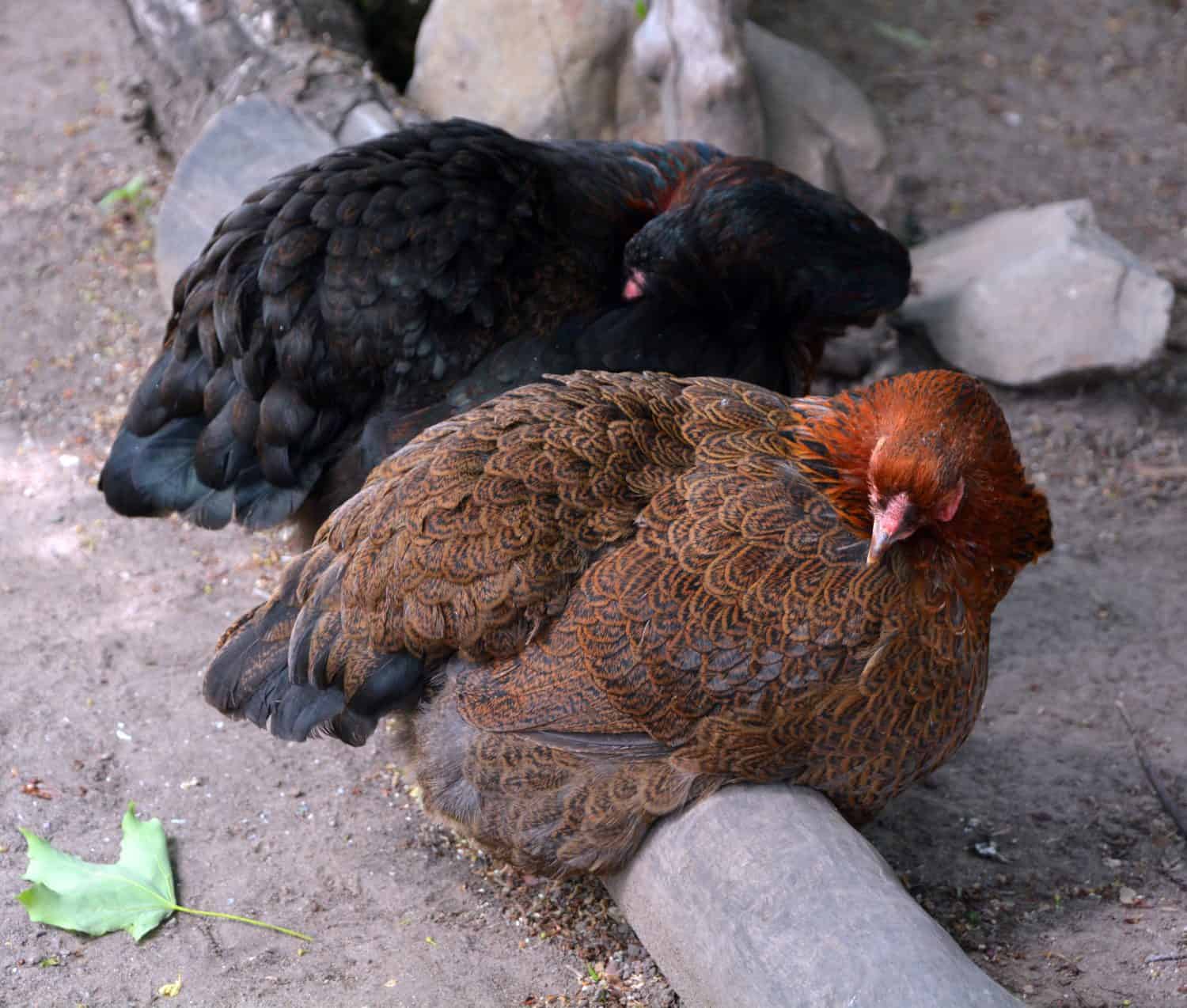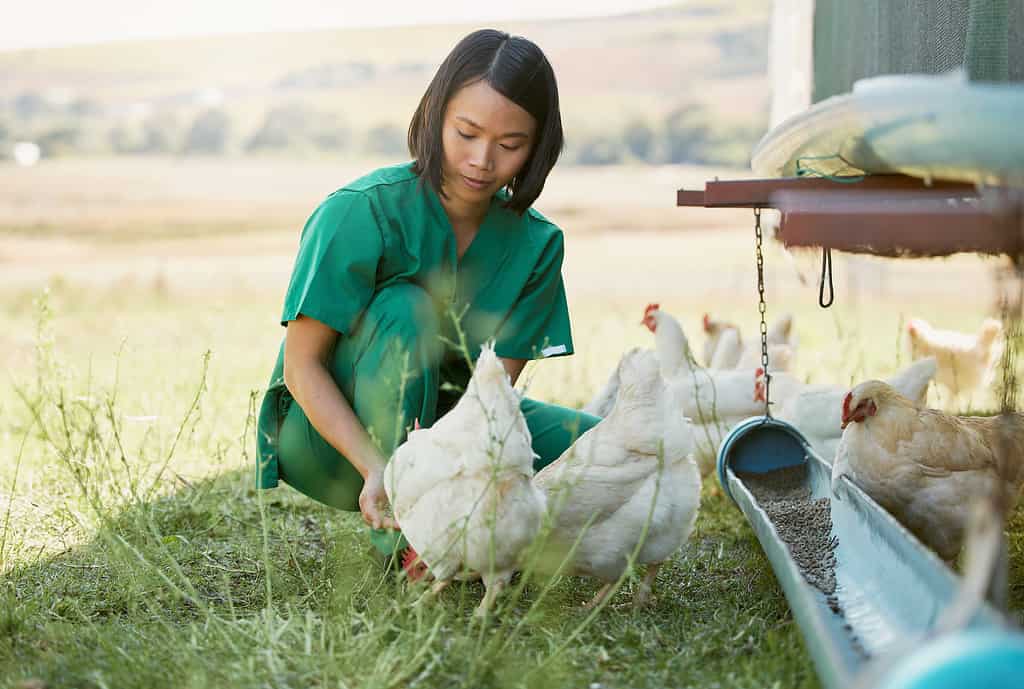Not long ago, you only saw Cornish chickens in the grocery store or on a restaurant menu. Today, it’s not uncommon to find them in your neighborhood. As backyard chicken coops have increased in popularity, these small birds are among the favored chicken breeds to keep. For chicken owners who have smaller yards, the size of Cornish chickens is appealing. Factors such as price, feed, and care are also considerations when choosing a flock.
What Makes a Cornish Chicken Different?

The Cornish displays short wings and stocky legs.
Cornish chickens are chicken, but they’re a little different than the standard chicken in the grocery store. While Cornish chickens are smaller, they still provide about six pounds of meat per fully-grown bird. The meat of a Cornish chicken is also different. Unlike other chickens, Cornish chickens have a low amount of dark meat. This makes them lower in fat and cholesterol. Cornish chickens are unable to fly due to the heaviness of their chest.
Personality

Plymouth Rock roosters are the result of a cross between a Cornish and a White Rock chicken.
©Mshake/iStock via Getty Images
The Cornish prefer to be the boss of the chicken coop. Cornish roosters may display serious aggression with other roosters. Many chicken owners prefer to only have one rooster for their flock to avoid fighting.
Within flocks, Cornish hens will establish a ‘pecking order.’ They may be aggressive to other birds, but friendly with their owners. Within the hens of the flock, there will be a dominant bird naturally in charge. Unlike other chicken breeds, Cornish do well with just a few other chickens in their flock.
While they can’t fly, Cornish do enjoy walking short distances. They can free range for short distances, and will happily eat insects that they find in the grass. The breed is prone to heart and leg problems, and shouldn’t engage in over-exertion. Smaller areas to forage supply enough exercise.
Roosters crow frequently, and hens cluck among the flock. Hens may also ‘egg sing’, clucking, chirping, and cooing while nesting.
Appearance

Cornish chickens are social but can be aggressive if irritated by flock members.
©Drakuliren/Shutterstock.com
Cornish chickens can be of many colors, with feathers that range from white to iridescent greens and blue. They have squat, muscular bodies and shorter, upturned tails. Their beaks tend to curve down, and their faces have smaller combs and wattles. Combs and wattles, unfeathered areas above and below the beak, help chickens regulate their body temperature. This breed has short legs and tight, narrow feathers. Hens grow to an average of eight pounds, while roosters reach an average weight of ten pounds.
| Size | Six to eight pounds. |
| Color | White, buff, green, brown, or blue. |
| Feather Type | Short, tight, narrow feathers that have no down. |
| Comb and Wattle | Small, close to the body. |
| Neck and Head | Stocky necks with small, rounded heads. Deep-set eyes, prominent brow, curved beak. |
| Body | Small, close to the body. |
| Legs and Feet | Well-spaced, shorter legs. |
How Did the Breed Originate?

Chicken breeds are often crossed to combine appealing traits in one bird.
©iStock.com/Polawat Klinkulabhirun
Cornish chickens were first bred around 1807 in England. To produce sporting birds, breeders crossed smaller chickens with muscular chickens. This is why the Cornish chicken has such a large chest, as breeders wanted a small, fast bird with strong muscles. As a result, the breed was stocky but slow. In 1893, the American Poultry Association accepted the breed under the name of ‘Indian Game.” As chicken fighting became illegal, the breed found its way into market production.
People who raised chicken for market or personal use had trouble with the Cornish. The bird was slow-growing and produced small eggs with colored shells. Later, however, young Cornish chickens were marketed as novelty meat birds, sold in individual servings. Finally, the Cornish were cross-bred with American chickens. This produced a meaty, fast-growing bird that has become a staple in chicken production. In fact, the majority of chickens raised for meat are Cornish Cross, the result of a Cornish and Rock chicken breed.
How Much Does it Cost to Raise Cornish Chickens?

A chicken coop is necessary if you’re raising Cornish chickens. Their feathers leave them vulnerable to cold.
©Courtney Jenckes/Shutterstock.com
Live Cornish chicks are available for sale at under two dollars each at most farming supply stores. In addition to this expense, Cornish chickens need a coop or enclosure. Due to their lack of downy feathers, the birds are susceptible to the environment. Wet or cold conditions can harm your birds without shelter. The shelter should have a bed of hay or wood shavings for easy cleaning.
Cornish chickens, like all chickens, need two different types of food. For the first few weeks of their lives, they will eat what’s called starter feed. Starter feed meets the special nutritional needs of baby chickens. After this, most owners switch their birds to a ‘grow’ feed, formulated to help the bird gain weight and muscle mass. While prices for these supplies may vary, the average cost to raise a Cornish to an adult is eight dollars. Adults of this breed live between five and eight years.
| Initial Purchase | $2.00 |
| Chicken Coop | $300.00 |
| Shavings and Bedding | $20.00 per bag |
| Starter Feed Cost | $40.00 per bag |
| Adult Feed Cost | $25.00 per bag |
Do Cornish Chickens Produce Eggs?

Cornish chickens will lay eggs, but not as much as other breeds.
©Gaga Mumladze/Shutterstock.com
While the breed does produce eggs, they’re not kept for either egg production or breeding. A Cornish chicken will produce between 50 and 100 eggs per year. While this may be enough for a family, it’s not considered profitable for the market. Their eggs are medium to large with white, cream-colored, or brown shells. Interestingly, white hens will most often lay white eggs, while darker eggs are more common with darker hens.
Hens are broody but have specific traits that hamper chick development. Hens must have adequate shavings or other padding to build their nests. Without this, the hen’s weight may damage her eggs. Due to the Cornish hen’s tight, light feathers, she may not be able to provide enough heat for incubation. Providing sheltered nesting areas with insulation can help ensure hatching success. Some Cornish chicken owners choose to incubate the eggs in an incubator instead. Despite this, hens are excellent caretakers.
Do Cornish Chickens Have Health Concerns?

Cornish chickens are slow, heavy birds that can become obese.
©meunierd/Shutterstock.com
The most common health concern with this breed is their tendency to become obese. Cornish chickens are slow, heavy birds. Additionally, they’re known to overeat if food is available. Subsequently, your bird may become too heavy for their legs to support. For that reason, it’s important to monitor your flock’s diet.
All chickens are prone to leg injury and parasites as a result of their unprotected legs. Owners can reduce the risk by feeding a high-quality formula fortified with vitamin B and minerals. Spraying the chicken’s legs with vegetable oil can deter mites.
The Cornish breed is also noted to have heart failure, which is common in all large game birds. Signs that your chicken may have heart failure will show in the comb and wattle. These areas will become thinner, firmer, and lose color. Your chicken’s abdomen may swell, or they may develop a cough. Treatment is supportive, with a restricted diet and isolation to limit exercise.
General Chicken Care

Regular veterinarian checks can keep your flock healthy.
©iStock.com/PeopleImages
Whether you decide to keep Cornish chickens or another breed, chickens need basic care to maintain their health. Chickens should be let out of their coop every morning and returned every evening. Be sure to provide your chickens with fresh food and water daily. Replace the bedding in your coop weekly to limit the chance of bacteria growth. Chickens that are broody or appear ill should be isolated from the flock to avoid contamination. If you notice that your chickens are fighting one another, they may not have enough space in their coop. Try to provide extra space for your chickens through staggered pasture time.
The photo featured at the top of this post is © Cindy Dillon/Shutterstock.com
Thank you for reading! Have some feedback for us? Contact the AZ Animals editorial team.







